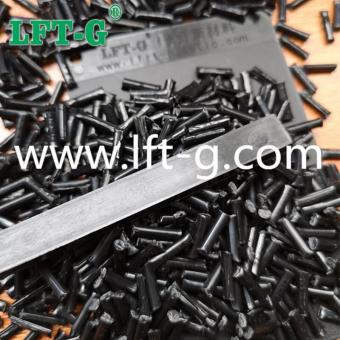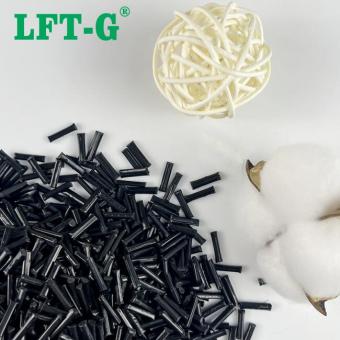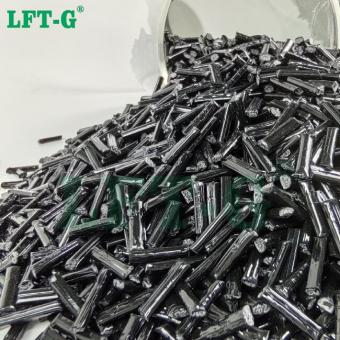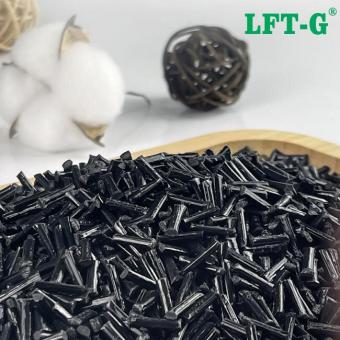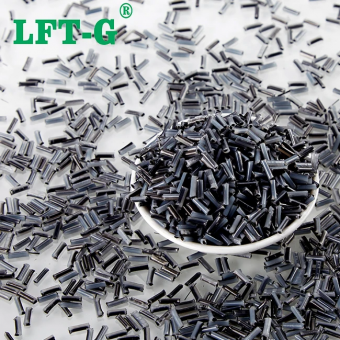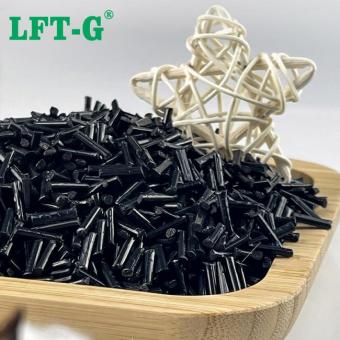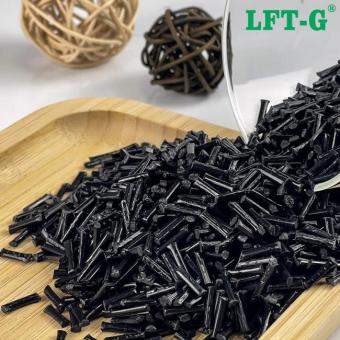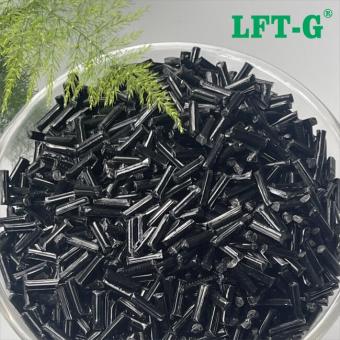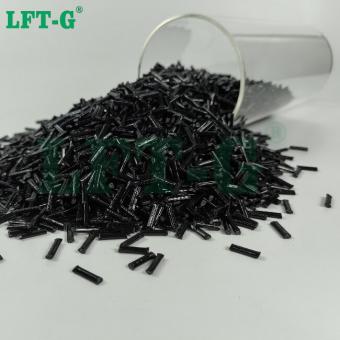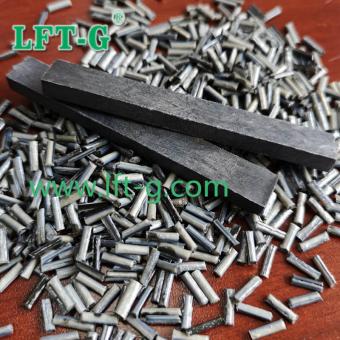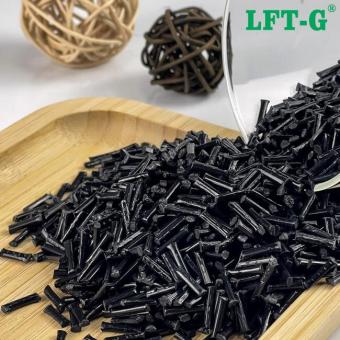Long carbon fiber is a new material with high strength and high modulus and excellent mechanical properties. It is a microcrystalline graphite material obtained by carbonization and graphitization of organic fibers. Its specific gravity is less than 1/4 of steel, and its strength is higher than that of steel. Corrosion resistant, high modulus, no melting. And a variety of resin substrates after impregnation extrusion molding into pellets, long carbon fiber polymer. Can be used for direct molding products. In recent years, it has been widely used in aerospace, mechanical and electronic chemicals.
-
Xiamen LFT-G Polyamide 66 Long Carbon Fiber filled wear resistance for auto partsThe main advantages of nylon 6 are its stiffness and resistance to abrasion. Moreover, this material has excellent impact strength, wear resistance, and electrical insulating properties.
- PA66 plastic raw materials injection molded
- PA66 recycled pure pellets light weight
- long carbon fiber pa66 natural black color
- pa66 lcf granules instead metal polymers
- Low warpage electronic appliance
- auto part and aerospace parts
Tags :
-
High Quality Nylon Polyamide 6 Long Carbon Fiber Reinforced PlasticsThe most notable physical property of polyamide is its excellent wear resistance due to its low coefficient of friction created by its self-lubricating properties.
- PA6 GFRP engineering plastic
- Manufacturer directly sell good price plastic
- Thermoplastic resin modified polymers
- customization service China manufacturer
- car parts lightweight instead metal
- composites made in China high toughness
Tags :
-
Homopolymer Polypropylene Long Carbon Fiber Reinforced Polymer for AutomotiveHomopolymer PP long carbon fiber composites offer excellent mechanical properties, including high strength, rigidity, and impact resistance. These materials are ideal for high-performance applications in automotive, aerospace, and industrial sectors, where lightweight yet durable solutions are essential. With superior dimensional stability and thermal resistance, homopolymer PP long carbon fiber composites provide a reliable alternative to metals in demanding environments.
- Carbon fiber high toughness pp
- Polypropylene resin China manufacture
- Thermoplastic resin made in China
- pp carbon fiber filament CF CFRP
- EDM wholesell on stock PP materials
- Best price PP high strength materials
Tags :
-
China Manufacturer PEEK Resin Long Carbon Fiber Reinforced PelletsPure PEEK itself is a special engineering plastic, with radiation resistance, self-lubrication, high temperature resistance, wear resistance, fatigue resistance and other characteristics. The performance of carbon fiber reinforced PEEK material has improved in many aspects compared with pure PEEK material. PEEK Long Carbon Fiber Reinforced Composite material is 5 times stronger than metal, 60% lighter and more than 10% better than similar products.
- PEEK materials supplier
- thermoplastic polymer plastic PEEK
- Factory sell Polyether ether ketone
- PEEK Carbon filled pellets
- Injection molding peek black color
- High strength PEEK properties
Tags :
-
LFT Nylon Polyamide 12 Long Carbon Fiber Reinforced CompoundsPA12 long carbon fiber reinforced material combines the excellent properties of polyamide 12 with the strength and stiffness of long carbon fibers. This high-performance composite offers superior mechanical strength, impact resistance, and dimensional stability, making it ideal for demanding applications in automotive, aerospace, and industrial sectors.
- PA12 long carbon fiber supplier
- PA12 composite 3D printing automotive
- pA66 filament polymer resin pellets
- EDM wholesale on stock PA 12 materials
- Best price PA12 high strength
Tags :
-
LFT Nylon Polyamide 66 Long Carbon Fiber Reinforced CompoundsPA66-CF40 is a 40% long carbon fiber-reinforced PA 66, offering exceptional strength, creep resistance, rigidity, and dimensional stability. After modification, PA66-CF40 exhibits outstanding mechanical properties, making it highly resilient and ideal for high-load applications in extreme temperature environments. This material is particularly suitable for components that require high strength and durability over extended periods, such as covers and structural parts in machines and vehicles.
- PA66 PA filler CFRP 40 30 20
- pa66-cf30 polymaker application
- EDM wholesale on stock PA 66 materials
- Best price PA66 high strength
Tags :
-
Nylon Polyamide 6 Filling Long Carbon Fiber Reinforced CompoundsPA6 long carbon fiber composites offer exceptional strength, stiffness, and low weight, making them ideal for high-performance applications in industries like automotive, aerospace, and electronics. These materials provide superior mechanical properties, including high tensile strength and excellent fatigue resistance, while also ensuring enhanced dimensional stability under extreme conditions. PA6 long carbon fiber composites are a reliable solution for replacing metals in demanding, lightweight structural components.
- PA6 PA filler CFRP 40 30
- pa6-cf30 polymaker application
- pA6 carbon fiber filament
- EDM wholesell on stock PA6 materials
- Best price PA6 high strength
Tags :
-
Homopolymer Polypropylene filling Long Carbon Fiber Polymer for AutomotiveHomopolymer PP long carbon fiber composites offer excellent mechanical properties, including high strength, rigidity, and impact resistance. These materials are ideal for high-performance applications in automotive, aerospace, and industrial sectors, where lightweight yet durable solutions are essential. With superior dimensional stability and thermal resistance, homopolymer PP long carbon fiber composites provide a reliable alternative to metals in demanding environments.
- Best priice PP high strength
Tags :
-
Extra High Strength Copolymer Polypropylene Long Carbon Fiber FilledCopolymer long carbon fiber reinforced polypropylene (PP) combines the benefits of long carbon fibers and the flexibility of PP copolymers, offering exceptional strength, stiffness, and impact resistance. It is ideal for demanding applications in industries such as automotive, electronics, and aerospace, where high mechanical performance and low weight are essential. This material provides superior dimensional stability, heat resistance, and improved resistance to fatigue and wear.
- pp carbon fiber
- CFRP recycled Lightweight instead metal
- carbon fiber reinforced pp
- carbon fiber 3D printed parts
- Best priice PP high tensile
Tags :
-
UltraStrong Carbon Fiber Reinforced PEEK Composite – High-Performance Engineering MaterialPEEK carbon fiber reinforced composite materials combine the high-performance properties of PEEK with the strength and durability of carbon fiber, making them ideal for applications in extreme environments and 3D printing.
- High Temperature Plastic
- PEEK Composite Materials
- Carbon Fiber Reinforced PEEK
- High Performance Plastics
- 3D Printing PEEK
- PEEK Material Applications
Tags :
-
LFT-G™ Premium Long Carbon Fiber Reinforced Homopolymer Polypropylene (PP) for High-Performance ApplicationsOur Long Carbon Fiber PP is a high-performance polypropylene composite, engineered for exceptional strength and lightweight properties, making it ideal for demanding applications like automotive parts.
- PP Composite Materials
- Carbon Fiber PP for Automotive
- Lightweight Carbon Fiber Plastic
- Long Carbon Fiber PP
- Carbon Fiber Reinforced Polypropylene
- High-Performance Polypropylene
Tags :

 e-mail
e-mail English
English français
français Deutsch
Deutsch русский
русский italiano
italiano español
español português
português العربية
العربية 日本語
日本語 한국의
한국의 中文
中文












